Introduction
The first time I cooked shirataki noodles, I almost gave up on them.
They were slippery, oddly scented, and nothing like the handmade noodles I learned to stretch in my grandmother’s kitchen. But as someone who’s spent her life chasing noodle perfection from Tokyo to Tuscany, I wasn’t ready to quit.
So I experimented.
With a little rinsing, boiling, and dry pan-frying, those strange noodles became something beautiful—tender, neutral, and ready to soak up whatever sauce I had simmering. Now they’re one of my favorite low-carb swaps, especially for busy nights when I want something light but satisfying.
Let me show you how to make shirataki noodles the right way—because they deserve a spot in your noodle story too.

Discover how shirataki compares to other noodles in our complete varieties guide.
What Are Shirataki Noodles?
Shirataki noodles, also called konjac or miracle noodles, are long, translucent noodles made from the root of the konjac plant, a starchy vegetable grown in parts of Asia. Their main ingredient, glucomannan, is a soluble fiber that gives shirataki its signature bounce and near-zero calorie profile.
What makes them special? They’re:
- Almost entirely water and fiber
- Keto-friendly, gluten-free, and low in carbs
- Flavorless on their own—but soak up sauces beautifully
You’ll usually find them packed in liquid and ready to heat, but don’t just rinse and go. With the right prep (I’ll show you how), they transform from rubbery to tender and satisfying.
Types of Shirataki Noodles
Not all shirataki is the same. Look for:
- Pure konjac noodles – firm noodles, perfect for stir-fries.
- Tofu shirataki – blended with soy, softer in texture
- Branded versions like Miracle Noodles – similar in function
If you’re new to shirataki, tofu versions can be gentler in taste. But for serious flavor and chew, I recommend konjac-only.
Want to compare them to other noodles? Check out our complete noodle guide.
How to Cook Shirataki Noodles (Step-by-Step Method)
Cooking shirataki noodles isn’t hard—but it does require a few key steps most people skip. Get this right, and you’ll go from slimy, rubbery noodles to something creamy, tender, and completely crave-worthy.
This is my go-to method—the same one I teach students and use in my own kitchen when I want low-carb comfort without compromise.
Step 1: Rinse Thoroughly
Place the noodles in a colander and rinse them under cold running water for at least 1–2 minutes. This helps remove the preserving liquid (and that strong smell).
Tip: Use your fingers or a fork to move the noodles around as you rinse—this helps loosen and wash away the excess starch and odor.
Step 2: Boil Briefly
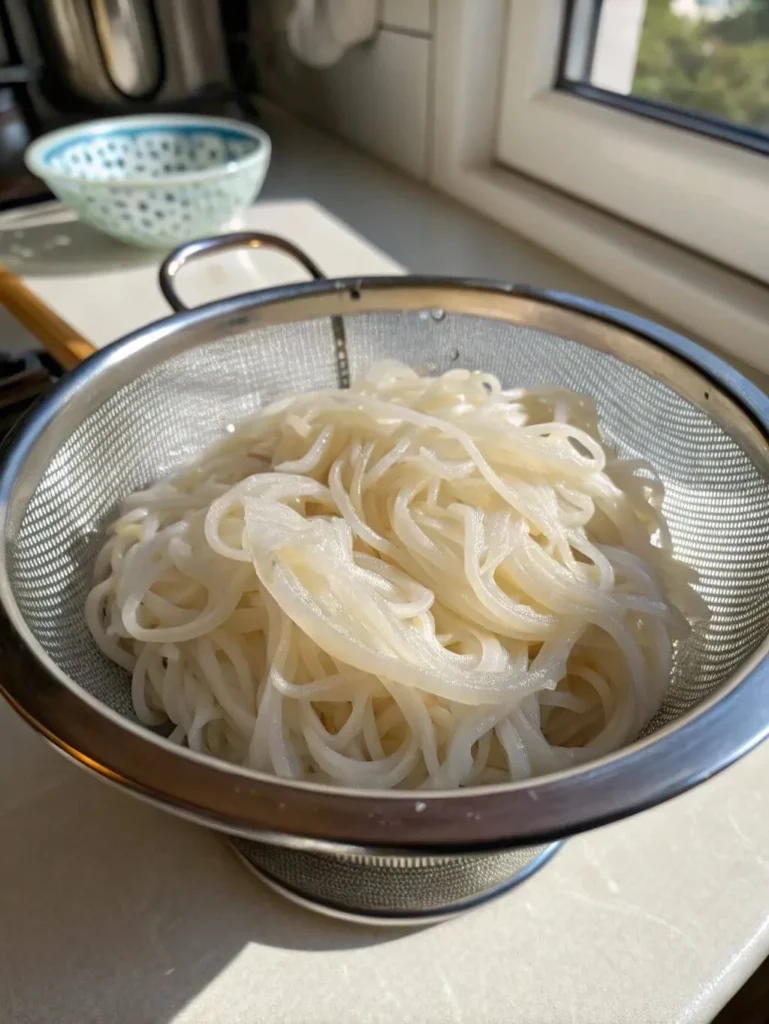
Bring a pot of water to a rolling boil. Add the noodles and boil for 2–3 minutes.
Why? Boiling improves the texture and softens the chew. It’s optional, but I highly recommend it.
Drain immediately and give them one more rinse under warm water.
Step 3: Dry the Noodles
Spread the noodles out on paper towels or a clean dish towel. Pat dry as much as possible.
Why it matters: Shirataki noodles hold a lot of water. If you skip this step, your sauce won’t cling and your dish could turn watery.
Step 4: Stir-Fry (Without Oil)
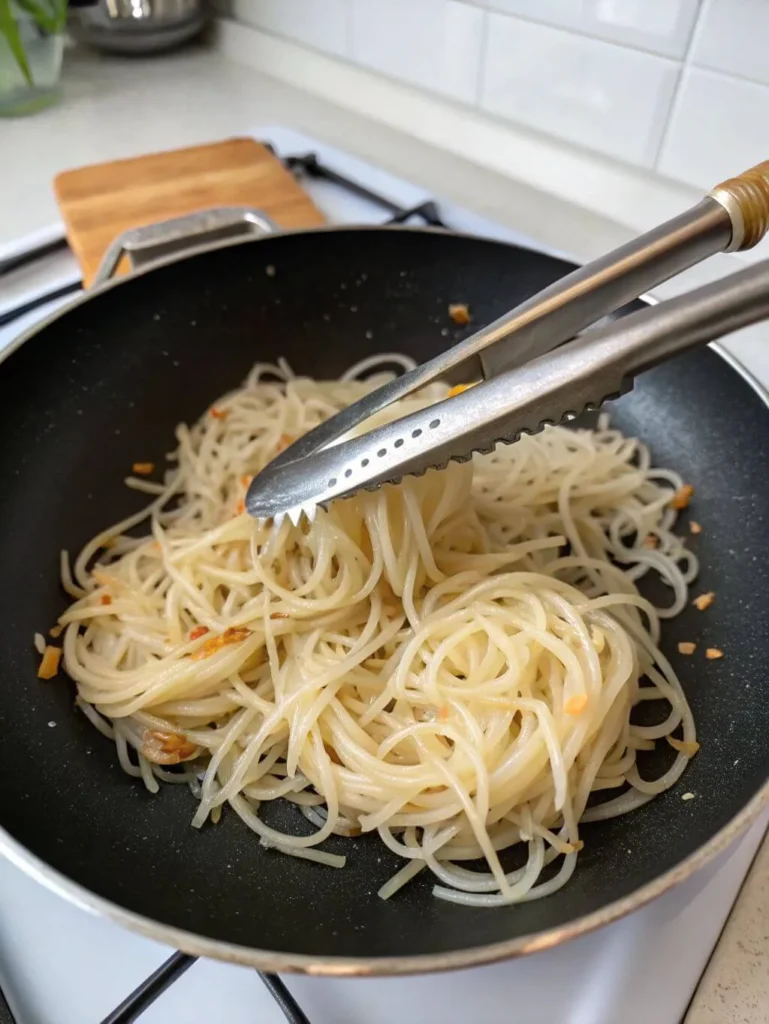
Heat a clean, dry skillet over medium-high heat. Add the noodles and stir-fry for 5–7 minutes, turning often.
The goal here is to cook off excess moisture. You’ll know they’re ready when the pan starts to look dry and the noodles feel slightly firm.
Avoid browning them—this is about drying, not searing.
Step 5: Add to Sauce
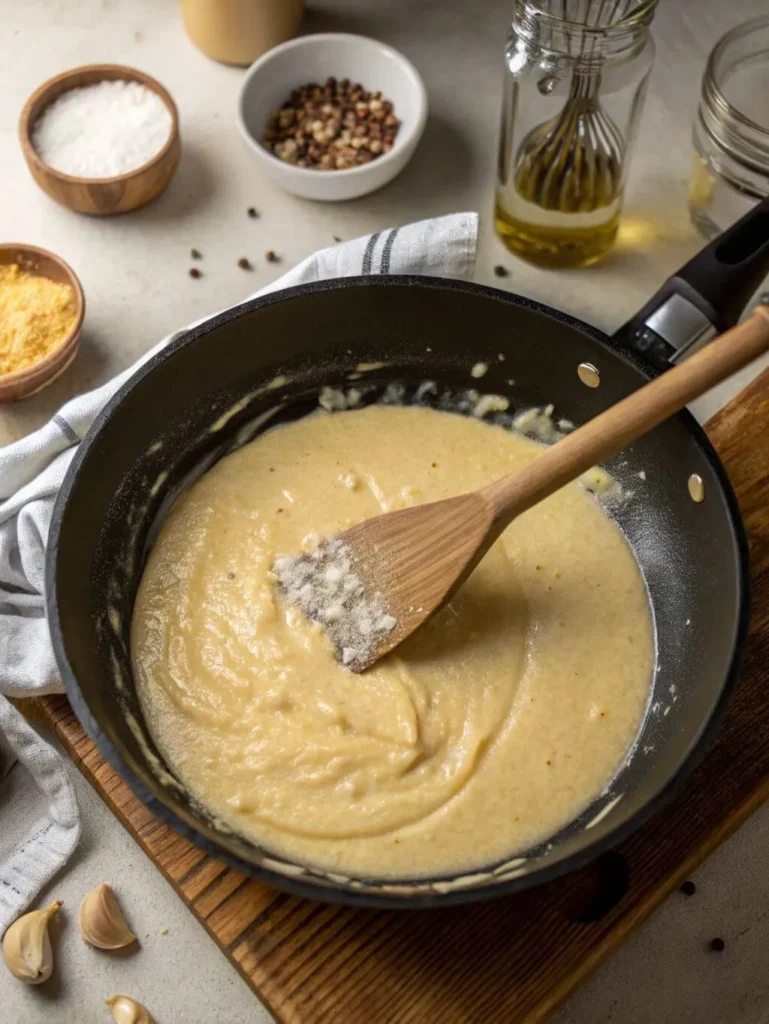
Once the noodles are dry and warm, it’s time for the fun part—tossing them in sauce!
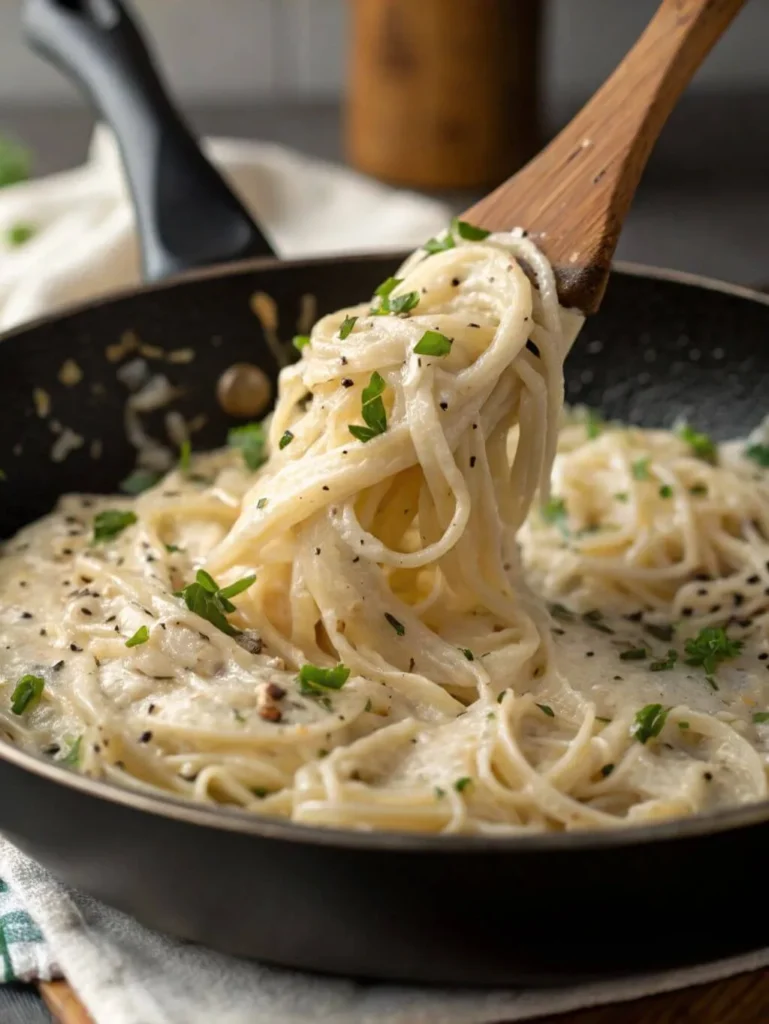
Shirataki Noodles recipe nutrition breakdown
You can use any sauce you like (we’ll talk about those next), but make sure it’s already hot. Shirataki noodles don’t need long in sauce—just a minute or two to absorb flavor.
Recap: Best Texture Checklist
| Step | Purpose |
|---|---|
| Rinse | Removes odor and slime |
| Boil | Softens and improves texture |
| Dry | Helps sauce cling properly |
| Stir-fry | Evaporates moisture, firms up |
| Sauce Toss | Adds flavor, binds the dish |
❗ Olivia’s Tip
Always heat your sauce before adding the noodles. Shirataki noodles don’t need to simmer—just toss them in at the end and warm through. This keeps them firm and flavorful, never soggy.
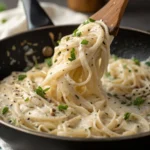
Shirataki Noodles
- Total Time: 20 minutes
- Yield: 2 servings 1x
Description
A creamy, flavorful low-carb noodle dish made with shirataki (konjac) noodles tossed in a garlic parmesan sauce. Keto-friendly, gluten-free, and perfect for busy weeknights. The secret lies in prepping the noodles right!
Ingredients
2 packs shirataki noodles (7 oz each), drained and rinsed
1 tbsp olive oil
2 cloves garlic, minced
1/4 cup chicken or vegetable broth
1/2 cup heavy cream
1/2 cup freshly grated parmesan cheese
Salt & black pepper to taste
1 tbsp chopped fresh parsley (optional, for garnish)
Instructions
-Rinse & drain: Open the shirataki noodles and place them in a colander. Rinse under cold water for 1-2 minutes to remove any odor.
-Boil: In a medium pot, bring water to a boil. Add the noodles and boil for 2–3 minutes. Drain again and pat dry thoroughly with paper towels.
-Dry stir-fry: Heat a skillet over medium-high heat. Add the noodles without oil and stir-fry for 5–7 minutes until all moisture is gone.
-Sauté garlic: In the same skillet, add olive oil and sauté minced garlic until fragrant (about 1 minute).
-Add liquids: Pour in the broth and cream. Reduce heat and simmer for 5 minutes until slightly thickened.
-Melt cheese: Add parmesan cheese, stirring until melted and creamy. Season with salt and pepper.
-Combine: Add noodles back to the pan and toss in the sauce until evenly coated and heated through.
-Serve: Garnish with chopped parsley and extra parmesan if desired.
Notes
-
Always pat shirataki noodles dry after boiling for best texture.
Sauce can be customized: swap parmesan for cream cheese or add chili flakes for heat.
Not a fan of cream? Sub coconut cream or almond milk for a dairy-free version.
- Prep Time: 5 minutes
- Cook Time: 15 minutes
- Category: Dinner, Low Carb
- Method: Boil, Stir-fry, Simmer
- Cuisine: Fusion (Asian-inspired with Italian flavor)
Nutrition
- Serving Size: 1 bowl
- Calories: 195 kcal
- Sugar: 1 g
- Sodium: 420 mg
- Fat: 14 g
- Saturated Fat: 5 g
- Unsaturated Fat: 7 g
- Trans Fat: 0 g
- Carbohydrates: 6 g
- Fiber: 3 g
- Protein: 6 g
- Cholesterol: 25 mg
Keywords: shirataki noodles, keto pasta, low carb noodles, miracle noodles, konjac noodles
Best Sauces and Pairings for Shirataki Noodles
Once your shirataki noodles are cooked the right way—rinsed, boiled, dried, and stir-fried—it’s time to give them what they need most: flavor. These noodles are like a blank canvas, and the sauce is your paintbrush.
Here are my favorite ways to dress them up, from rich and creamy to bright and spicy.
Garlic Parmesan Cream Sauce
A go-to in my kitchen, this sauce turns shirataki into a cozy, cheesy delight.
What you need:
- Olive oil
- Fresh garlic (minced)
- Heavy cream
- Chicken or veggie broth
- Freshly grated Parmesan
- Salt + pepper to taste
How to use it:
Sauté garlic in olive oil until fragrant. Add cream and broth. Simmer to reduce by half. Stir in Parmesan until thickened. Toss your noodles in and coat evenly.
Why it works:
The creamy richness clings beautifully to dried, stir-fried noodles, and the garlic helps mask any leftover konjac flavor.
Asian-Inspired Soy Sesame Sauce
If you’re in the mood for something lighter, this one brings umami, heat, and nuttiness to the table.
You’ll need:
- Soy sauce
- Rice vinegar
- Toasted sesame oil
- Garlic and ginger
- Chili flakes or Sriracha
- Optional: a touch of peanut butter for depth
Use this for:
Quick stir-fries with bok choy, mushrooms, or tofu. It’s especially delicious topped with scallions and a sprinkle of sesame seeds.
Classic Tomato-Based Marinara (Low-Carb)
Prefer an Italian spin? Shirataki noodles can hold their own with tomato-based sauces too.
Pair them with:
- Sugar-free marinara
- Italian meat sauce
- Keto turkey bolognese
- Plant-based lentil ragu
Pro tip: Tofu shirataki works well with red sauces because of its smoother, slightly softer texture.
Other Flavorful Pairings to Try
| Sauce Type | Best With |
|---|---|
| Alfredo Sauce | Fettuccine-style shirataki, grilled chicken |
| Pesto Sauce | Tofu shirataki, summer veggies, cherry tomatoes |
| Mushroom Sauce | Konjac noodles, ground beef or sautéed tofu |
| Creamy Cheese Sauce | Great for picky eaters or a fun comfort-food twist |
| Asian Peanut Sauce | Stir-fried shirataki, snap peas, and carrots |
❗ Olivia’s Tip
Always heat your sauce before adding the noodles. Shirataki noodles don’t need to simmer—just toss them in at the end and warm through. This keeps them firm and flavorful, never soggy.
Shirataki Noodles vs Traditional Pasta
One of the biggest questions I get from readers is, “Do shirataki noodles really feel like pasta?” The short answer: they can—if you prepare them right. But to understand how they compare, let’s break it down.
Taste & Texture: What to Expect
| Feature | Shirataki Noodles | Traditional Pasta |
|---|---|---|
| Flavor | Very mild, absorbs sauce easily | Slightly wheaty, richer on its own |
| Texture | Springy, slippery (but firm when cooked right) | Soft, chewy, starchy |
| Smell (raw) | Slight fishy scent (rinses away) | Neutral |
Shirataki won’t taste exactly like semolina pasta. But once dry-fried and sauced properly, the bite and body come surprisingly close—especially for light, creamy, or stir-fried dishes.
Nutrition Breakdown
Here’s how shirataki noodles stack up nutritionally against common pasta types (per 3 oz serving):
| Type | Calories | Net Carbs | Fiber | Protein | Gluten-Free |
|---|---|---|---|---|---|
| Shirataki | 10–15 | 0–1g | 2–3g | 0g | Yes |
| Wheat Spaghetti | ~200 | 40g | 2g | 7g | No |
| Chickpea Pasta | ~190 | 30g | 5g | 13g | Yes |
| Zoodles (Zucchini) | ~20 | 4g | 1g | 1g | Yes |
Who Benefits Most from Shirataki?
Shirataki noodles are ideal for:
- Low-carb and keto dieters
- People with gluten intolerance or celiac
- Anyone managing blood sugar levels
- Weight-loss plans focused on volume with low calories
- Perfect for busy weeknights when you crave comfort food without the guilt.
Honestly, they’re perfect for anyone who loves noodles but wants a lighter way to enjoy them more often.
Craving pasta with a creamy twist? Don’t miss our fettuccine alfredo recipe—it’s easy to adapt using shirataki.
Frequently Asked Questions: Shirataki Noodles
Are shirataki noodles really healthy?
Yes, shirataki noodles are considered very healthy for most people. They’re naturally low in calories, contain almost no digestible carbs, and are made mostly of water and glucomannan fiber, which supports digestion and can help with blood sugar control.
Because they’re free of gluten, grains, and sugar, they fit well into:
Keto and low-carb diets
Diabetic meal plans
Paleo or Whole30 programs
Weight-loss routines
That said, they don’t offer much protein or micronutrients—so for a balanced meal, pair them with protein and veggies.
What is the best way to cook shirataki noodles?
The best method includes a few simple but essential steps:
Rinse thoroughly to remove the packaging liquid and odor.
Boil briefly to soften the texture and remove any residual smell.
Dry and stir-fry in a hot pan (with no oil) to remove excess moisture and firm them up.
Add them to your heated sauce at the end to keep them from getting soggy.
Skip the microwave and don’t simmer them too long in sauce—they’ll turn mushy.
What’s the catch with shirataki noodles?
The biggest “catch” is the texture and the smell—if they’re not prepared right.
Texture: Out of the bag, they’re rubbery and slippery. But after boiling and dry-frying, they become more like traditional pasta.
Smell: Some people describe the liquid as fishy—it’s actually the alkaline storage solution. Rinsing and boiling eliminates it.
Nutrient profile: They’re extremely low in calories, which is great—but they lack protein and essential vitamins. Make sure to build a full, nutritious meal around them.
Once you master the method, shirataki noodles become a flexible, healthy, and totally satisfying swap for regular pasta.
Conclusion
Shirataki noodles might seem intimidating at first—with their unusual texture and scent—but once you learn how to prep them properly, they become one of the most versatile and satisfying low-carb noodle swaps out there.
Whether you’re following a keto lifestyle, managing your blood sugar, or just craving something light and comforting, these “miracle noodles” are worth a place in your pantry. From garlic parmesan to spicy ramen-style bowls, shirataki noodles can do it all—without the carbs or guilt.
Looking for other fun ways to cook with noodles?
Don’t miss our lo mein noodles recipe for a saucy stir-fry twist.
Discover great ideas like our chinese chow mein for classic takeout at home.
Check out our homemade pappardelle for a from-scratch experience.
Looking for inspiration? Try our angel hair pasta recipe as a delicate contrast to shirataki.


3 thoughts on “Shirataki Noodles: Best Cooking Method, Health Facts & Flavor Hacks”